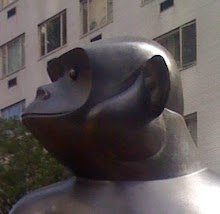
Tree grates exist to protect trees from city stress, especially from potential compaction of the soil around the tree trunk. The soil needs to breath the air and absorb rainwater. The grates also protect from trash and other waste (like from dogs!) collecting around the base. Even foot traffic can be a hazard because of the high volume.

Trees have a hard life in the city. The air pollution from the cars and trucks poses the biggest threat, and I bet the sound pollution hurts them, too, but this is not proven. They get rammed by cars and trucks trying to park and by bulldozers making necessary repairs to streets and sidewalks.

Trees need to drink lots of water, with the major sources being rain and snow. Most of the water absorption comes through the roots, which typically stretch the width of the tree canopy, and sometimes even more. So most city trees are automatical

ly at a disadvantage, just be being in the sidewalk; the total root system is rarely exposed to the elements above.

The life of the street tree is said to be 10 years, which is easy to believe, given all the stress. But the source of that statistic is one woman observing life outside her window. No really good studies exist to prove this.

 Tree grates exist to protect trees from city stress, especially from potential compaction of the soil around the tree trunk. The soil needs to breath the air and absorb rainwater. The grates also protect from trash and other waste (like from dogs!) collecting around the base. Even foot traffic can be a hazard because of the high volume.
Tree grates exist to protect trees from city stress, especially from potential compaction of the soil around the tree trunk. The soil needs to breath the air and absorb rainwater. The grates also protect from trash and other waste (like from dogs!) collecting around the base. Even foot traffic can be a hazard because of the high volume. Trees have a hard life in the city. The air pollution from the cars and trucks poses the biggest threat, and I bet the sound pollution hurts them, too, but this is not proven. They get rammed by cars and trucks trying to park and by bulldozers making necessary repairs to streets and sidewalks.
Trees have a hard life in the city. The air pollution from the cars and trucks poses the biggest threat, and I bet the sound pollution hurts them, too, but this is not proven. They get rammed by cars and trucks trying to park and by bulldozers making necessary repairs to streets and sidewalks. Trees need to drink lots of water, with the major sources being rain and snow. Most of the water absorption comes through the roots, which typically stretch the width of the tree canopy, and sometimes even more. So most city trees are automatical
Trees need to drink lots of water, with the major sources being rain and snow. Most of the water absorption comes through the roots, which typically stretch the width of the tree canopy, and sometimes even more. So most city trees are automatical ly at a disadvantage, just be being in the sidewalk; the total root system is rarely exposed to the elements above.
ly at a disadvantage, just be being in the sidewalk; the total root system is rarely exposed to the elements above. The life of the street tree is said to be 10 years, which is easy to believe, given all the stress. But the source of that statistic is one woman observing life outside her window. No really good studies exist to prove this.
The life of the street tree is said to be 10 years, which is easy to believe, given all the stress. But the source of that statistic is one woman observing life outside her window. No really good studies exist to prove this.


